Java EE WEB工程师培训-JDBC+Servlet+JSP整合开发之17.Session
�CSession 简介
�CSession API
�CSession 实例
• 登录Session
�CSession API
�CSession 实例
• 登录Session
#################Michael分割线####################
• Session 简介
�C由于HTTP协议的无状态性,无法持久保持对象的状态,那么怎么才能实现持久保存对象的状态呢?
�C由于HTTP协议的无状态性,无法持久保持对象的状态,那么怎么才能实现持久保存对象的状态呢?
Java的解决方案有两种:
• Cookie
�C见上一节
• Session
�CSession 是用来跟踪用户当前状态的一种机制,是针对浏览器和服务器的一对一关系。
�CSession 的一般用法是,在用户登录时将用户的登录信息保存到session中,以便以后使用。
• Cookie
�C见上一节
• Session
�CSession 是用来跟踪用户当前状态的一种机制,是针对浏览器和服务器的一对一关系。
�CSession 的一般用法是,在用户登录时将用户的登录信息保存到session中,以便以后使用。
• Session API
�CSession 接口HttpSession
• 通常我们只使用HttpSession接口,接口的实现由web容器来完成
�C获得HttpSession
• 可以从HttpServletRequest中获得HttpSession
�Crequest.getSession();
�C将信息保存在HttpSession中
• session.setAttribute(“UserSession”,obj);
�C从HttpSession中获得信息
• session.getAttribute(“UserSession”);
�C使HttpSession失效
• session.invalidate();
�CSession 接口HttpSession
• 通常我们只使用HttpSession接口,接口的实现由web容器来完成
�C获得HttpSession
• 可以从HttpServletRequest中获得HttpSession
�Crequest.getSession();
�C将信息保存在HttpSession中
• session.setAttribute(“UserSession”,obj);
�C从HttpSession中获得信息
• session.getAttribute(“UserSession”);
�C使HttpSession失效
• session.invalidate();
SessionServlet.java
package com.michael.servlet;
import java.io.IOException;
import java.io.PrintWriter;
import javax.servlet.ServletException;
import javax.servlet.http.HttpServlet;
import javax.servlet.http.HttpServletRequest;
import javax.servlet.http.HttpServletResponse;
import javax.servlet.http.HttpSession;
public class SessionServlet extends HttpServlet {
/**
* Constructor of the object.
*/
public SessionServlet() {
super();
}
/**
* Destruction of the servlet. <br>
*/
public void destroy() {
super.destroy(); // Just puts "destroy" string in log
// Put your code here
}
/**
* The doGet method of the servlet. <br>
*
* This method is called when a form has its tag value method equals to get.
*
* @param request the request send by the client to the server
* @param response the response send by the server to the client
* @throws ServletException if an error occurred
* @throws IOException if an error occurred
*/
public void doGet(HttpServletRequest request, HttpServletResponse response)
throws ServletException, IOException {
doPost(request,response);
}
/**
* The doPost method of the servlet. <br>
*
* This method is called when a form has its tag value method equals to post.
*
* @param request the request send by the client to the server
* @param response the response send by the server to the client
* @throws ServletException if an error occurred
* @throws IOException if an error occurred
*/
public void doPost(HttpServletRequest request, HttpServletResponse response)
throws ServletException, IOException {
HttpSession session = request.getSession();
session.setAttribute( "SessionObj", "session_Value");
response.setContentType( "text/html");
PrintWriter out = response.getWriter();
out
.println( "<!DOCTYPE HTML PUBLIC \"-//W3C//DTD HTML 4.01 Transitional//EN\">");
out.println("<HTML>");
out.println(" <HEAD><TITLE>A Servlet</TITLE></HEAD>");
out.println(" <BODY>");
out.print(" This is ");
out.print(this.getClass());
out.println(", using the POST method");
out.println(" </BODY>");
out.println("</HTML>");
out.flush();
out.close();
}
/**
* Initialization of the servlet. <br>
*
* @throws ServletException if an error occure
*/
public void init() throws ServletException {
// Put your code here
}
}
import java.io.IOException;
import java.io.PrintWriter;
import javax.servlet.ServletException;
import javax.servlet.http.HttpServlet;
import javax.servlet.http.HttpServletRequest;
import javax.servlet.http.HttpServletResponse;
import javax.servlet.http.HttpSession;
public class SessionServlet extends HttpServlet {
/**
* Constructor of the object.
*/
public SessionServlet() {
super();
}
/**
* Destruction of the servlet. <br>
*/
public void destroy() {
super.destroy(); // Just puts "destroy" string in log
// Put your code here
}
/**
* The doGet method of the servlet. <br>
*
* This method is called when a form has its tag value method equals to get.
*
* @param request the request send by the client to the server
* @param response the response send by the server to the client
* @throws ServletException if an error occurred
* @throws IOException if an error occurred
*/
public void doGet(HttpServletRequest request, HttpServletResponse response)
throws ServletException, IOException {
doPost(request,response);
}
/**
* The doPost method of the servlet. <br>
*
* This method is called when a form has its tag value method equals to post.
*
* @param request the request send by the client to the server
* @param response the response send by the server to the client
* @throws ServletException if an error occurred
* @throws IOException if an error occurred
*/
public void doPost(HttpServletRequest request, HttpServletResponse response)
throws ServletException, IOException {
HttpSession session = request.getSession();
session.setAttribute( "SessionObj", "session_Value");
response.setContentType( "text/html");
PrintWriter out = response.getWriter();
out
.println( "<!DOCTYPE HTML PUBLIC \"-//W3C//DTD HTML 4.01 Transitional//EN\">");
out.println("<HTML>");
out.println(" <HEAD><TITLE>A Servlet</TITLE></HEAD>");
out.println(" <BODY>");
out.print(" This is ");
out.print(this.getClass());
out.println(", using the POST method");
out.println(" </BODY>");
out.println("</HTML>");
out.flush();
out.close();
}
/**
* Initialization of the servlet. <br>
*
* @throws ServletException if an error occure
*/
public void init() throws ServletException {
// Put your code here
}
}
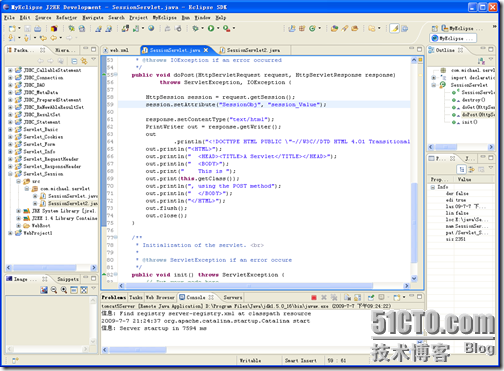
SessionServlet2.java
package com.michael.servlet;
import java.io.IOException;
import java.io.PrintWriter;
import javax.servlet.ServletException;
import javax.servlet.http.HttpServlet;
import javax.servlet.http.HttpServletRequest;
import javax.servlet.http.HttpServletResponse;
import javax.servlet.http.HttpSession;
public class SessionServlet2 extends HttpServlet {
/**
* Constructor of the object.
*/
public SessionServlet2() {
super();
}
/**
* Destruction of the servlet. <br>
*/
public void destroy() {
super.destroy(); // Just puts "destroy" string in log
// Put your code here
}
/**
* The doGet method of the servlet. <br>
*
* This method is called when a form has its tag value method equals to get.
*
* @param request the request send by the client to the server
* @param response the response send by the server to the client
* @throws ServletException if an error occurred
* @throws IOException if an error occurred
*/
public void doGet(HttpServletRequest request, HttpServletResponse response)
throws ServletException, IOException {
doPost(request,response);
}
/**
* The doPost method of the servlet. <br>
*
* This method is called when a form has its tag value method equals to post.
*
* @param request the request send by the client to the server
* @param response the response send by the server to the client
* @throws ServletException if an error occurred
* @throws IOException if an error occurred
*/
public void doPost(HttpServletRequest request, HttpServletResponse response)
throws ServletException, IOException {
HttpSession session = request.getSession();
String obj = (String) session.getAttribute( "SessionObj");
response.setContentType( "text/html");
PrintWriter out = response.getWriter();
out
.println( "<!DOCTYPE HTML PUBLIC \"-//W3C//DTD HTML 4.01 Transitional//EN\">");
out.println("<HTML>");
out.println(" <HEAD><TITLE>A Servlet</TITLE></HEAD>");
out.println(" <BODY>");
out.print(obj);
out.println(" </BODY>");
out.println("</HTML>");
out.flush();
out.close();
}
/**
* Initialization of the servlet. <br>
*
* @throws ServletException if an error occure
*/
public void init() throws ServletException {
// Put your code here
}
}
import java.io.IOException;
import java.io.PrintWriter;
import javax.servlet.ServletException;
import javax.servlet.http.HttpServlet;
import javax.servlet.http.HttpServletRequest;
import javax.servlet.http.HttpServletResponse;
import javax.servlet.http.HttpSession;
public class SessionServlet2 extends HttpServlet {
/**
* Constructor of the object.
*/
public SessionServlet2() {
super();
}
/**
* Destruction of the servlet. <br>
*/
public void destroy() {
super.destroy(); // Just puts "destroy" string in log
// Put your code here
}
/**
* The doGet method of the servlet. <br>
*
* This method is called when a form has its tag value method equals to get.
*
* @param request the request send by the client to the server
* @param response the response send by the server to the client
* @throws ServletException if an error occurred
* @throws IOException if an error occurred
*/
public void doGet(HttpServletRequest request, HttpServletResponse response)
throws ServletException, IOException {
doPost(request,response);
}
/**
* The doPost method of the servlet. <br>
*
* This method is called when a form has its tag value method equals to post.
*
* @param request the request send by the client to the server
* @param response the response send by the server to the client
* @throws ServletException if an error occurred
* @throws IOException if an error occurred
*/
public void doPost(HttpServletRequest request, HttpServletResponse response)
throws ServletException, IOException {
HttpSession session = request.getSession();
String obj = (String) session.getAttribute( "SessionObj");
response.setContentType( "text/html");
PrintWriter out = response.getWriter();
out
.println( "<!DOCTYPE HTML PUBLIC \"-//W3C//DTD HTML 4.01 Transitional//EN\">");
out.println("<HTML>");
out.println(" <HEAD><TITLE>A Servlet</TITLE></HEAD>");
out.println(" <BODY>");
out.print(obj);
out.println(" </BODY>");
out.println("</HTML>");
out.flush();
out.close();
}
/**
* Initialization of the servlet. <br>
*
* @throws ServletException if an error occure
*/
public void init() throws ServletException {
// Put your code here
}
}

看下效果
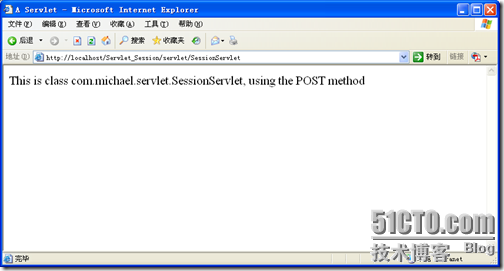
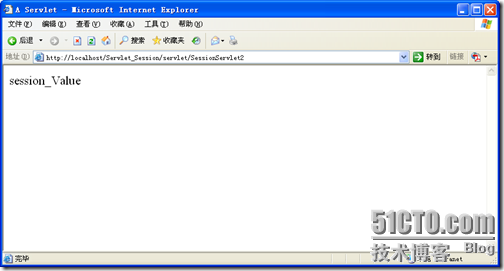
关闭IE后再打开测试
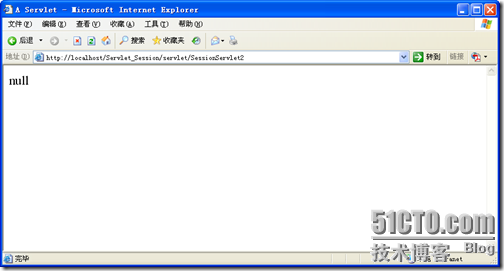
SessionServlet2.java
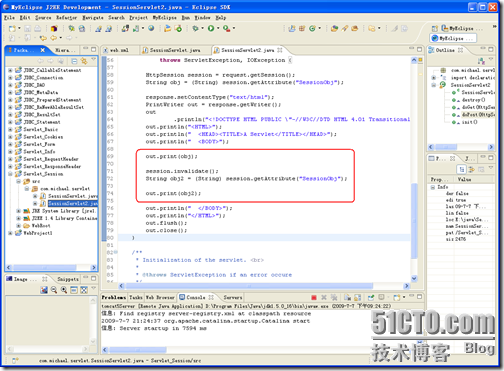
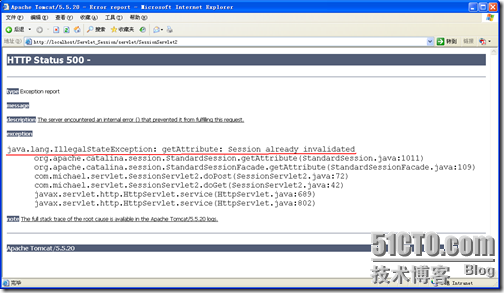
• Session 实例
�C登录Session
�C登录Session
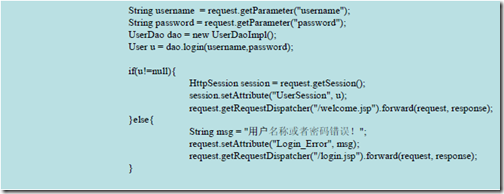
ConnectionUtil.java
package com.michael.dao.impl;
import java.sql.Connection;
import java.sql.PreparedStatement;
import java.sql.ResultSet;
import java.sql.SQLException;
import com.michael.dao.ConnectionUtil;
import com.michael.dao.User;
import com.michael.dao.UserDao;
public class UserDaoImpl implements UserDao {
public User login(String username, String password) {
Connection conn = new ConnectionUtil().openConnection();
String sql = "select id,name,password from UserTbl where name=? and password=?";
try {
PreparedStatement pstmt = conn.prepareStatement(sql);
pstmt.setString(1, username);
pstmt.setString(2, password);
ResultSet rs = pstmt.executeQuery();
if(rs.next()){
int id = rs.getInt(1);
User u = new User();
u.setId(id);
u.setUsername(username);
u.setPassword(password);
return u;
}
} catch (SQLException e) {
e.printStackTrace();
} finally{
try {
conn.close();
} catch (SQLException e) {
e.printStackTrace();
}
}
return null;
}
}
import java.sql.Connection;
import java.sql.PreparedStatement;
import java.sql.ResultSet;
import java.sql.SQLException;
import com.michael.dao.ConnectionUtil;
import com.michael.dao.User;
import com.michael.dao.UserDao;
public class UserDaoImpl implements UserDao {
public User login(String username, String password) {
Connection conn = new ConnectionUtil().openConnection();
String sql = "select id,name,password from UserTbl where name=? and password=?";
try {
PreparedStatement pstmt = conn.prepareStatement(sql);
pstmt.setString(1, username);
pstmt.setString(2, password);
ResultSet rs = pstmt.executeQuery();
if(rs.next()){
int id = rs.getInt(1);
User u = new User();
u.setId(id);
u.setUsername(username);
u.setPassword(password);
return u;
}
} catch (SQLException e) {
e.printStackTrace();
} finally{
try {
conn.close();
} catch (SQLException e) {
e.printStackTrace();
}
}
return null;
}
}
User.java
package com.michael.dao;
public class User {
private int id;
private String username;
private String password;
public int getId() {
return id;
}
public void setId( int id) {
this.id = id;
}
public String getPassword() {
return password;
}
public void setPassword(String password) {
this.password = password;
}
public String getUsername() {
return username;
}
public void setUsername(String username) {
this.username = username;
}
}
public class User {
private int id;
private String username;
private String password;
public int getId() {
return id;
}
public void setId( int id) {
this.id = id;
}
public String getPassword() {
return password;
}
public void setPassword(String password) {
this.password = password;
}
public String getUsername() {
return username;
}
public void setUsername(String username) {
this.username = username;
}
}
UserDao.java
package com.michael.dao;
public interface UserDao {
public User login(String username,String password);
}
public interface UserDao {
public User login(String username,String password);
}
UserDaoImpl.java
package com.michael.dao.impl;
import java.sql.Connection;
import java.sql.PreparedStatement;
import java.sql.ResultSet;
import java.sql.SQLException;
import com.michael.dao.ConnectionUtil;
import com.michael.dao.User;
import com.michael.dao.UserDao;
public class UserDaoImpl implements UserDao {
public User login(String username, String password) {
Connection conn = new ConnectionUtil().openConnection();
String sql = "select id,name,password from UserTbl where name=? and password=?";
try {
PreparedStatement pstmt = conn.prepareStatement(sql);
pstmt.setString(1, username);
pstmt.setString(2, password);
ResultSet rs = pstmt.executeQuery();
if(rs.next()){
int id = rs.getInt(1);
User u = new User();
u.setId(id);
u.setUsername(username);
u.setPassword(password);
return u;
}
} catch (SQLException e) {
e.printStackTrace();
} finally{
try {
conn.close();
} catch (SQLException e) {
e.printStackTrace();
}
}
return null;
}
}
import java.sql.Connection;
import java.sql.PreparedStatement;
import java.sql.ResultSet;
import java.sql.SQLException;
import com.michael.dao.ConnectionUtil;
import com.michael.dao.User;
import com.michael.dao.UserDao;
public class UserDaoImpl implements UserDao {
public User login(String username, String password) {
Connection conn = new ConnectionUtil().openConnection();
String sql = "select id,name,password from UserTbl where name=? and password=?";
try {
PreparedStatement pstmt = conn.prepareStatement(sql);
pstmt.setString(1, username);
pstmt.setString(2, password);
ResultSet rs = pstmt.executeQuery();
if(rs.next()){
int id = rs.getInt(1);
User u = new User();
u.setId(id);
u.setUsername(username);
u.setPassword(password);
return u;
}
} catch (SQLException e) {
e.printStackTrace();
} finally{
try {
conn.close();
} catch (SQLException e) {
e.printStackTrace();
}
}
return null;
}
}
LoginServlet.java
package com.michael.servlet;
import java.io.IOException;
import java.io.PrintWriter;
import javax.servlet.ServletException;
import javax.servlet.http.HttpServlet;
import javax.servlet.http.HttpServletRequest;
import javax.servlet.http.HttpServletResponse;
import javax.servlet.http.HttpSession;
import com.michael.dao.User;
import com.michael.dao.UserDao;
import com.michael.dao.impl.UserDaoImpl;
public class LoginServlet extends HttpServlet {
/**
* Constructor of the object.
*/
public LoginServlet() {
super();
}
/**
* Destruction of the servlet. <br>
*/
public void destroy() {
super.destroy(); // Just puts "destroy" string in log
// Put your code here
}
/**
* The doGet method of the servlet. <br>
*
* This method is called when a form has its tag value method equals to get.
*
* @param request the request send by the client to the server
* @param response the response send by the server to the client
* @throws ServletException if an error occurred
* @throws IOException if an error occurred
*/
public void doGet(HttpServletRequest request, HttpServletResponse response)
throws ServletException, IOException {
response.setContentType( "text/html");
PrintWriter out = response.getWriter();
out.println( "<!DOCTYPE HTML PUBLIC \"-//W3C//DTD HTML 4.01 Transitional//EN\">");
out.println("<HTML>");
out.println(" <HEAD><TITLE>A Servlet</TITLE></HEAD>");
out.println(" <BODY>");
out.print(" This is ");
out.print(this.getClass());
out.println(", using the GET method");
out.println(" </BODY>");
out.println("</HTML>");
out.flush();
out.close();
}
/**
* The doPost method of the servlet. <br>
*
* This method is called when a form has its tag value method equals to post.
*
* @param request the request send by the client to the server
* @param response the response send by the server to the client
* @throws ServletException if an error occurred
* @throws IOException if an error occurred
*/
public void doPost(HttpServletRequest request, HttpServletResponse response)
throws ServletException, IOException {
//获取用户名和密码
String username = request.getParameter("username");
String password = request.getParameter("password");
UserDao dao = new UserDaoImpl();
User u = dao.login(username,password);
if(u!=null){
HttpSession session = request.getSession();
session.setAttribute("UserSession", u);
request.getRequestDispatcher("/welcome.jsp").forward(request, response);
}else{
request.getRequestDispatcher("/failure.html").forward(request, response);
}
}
/**
* Initialization of the servlet. <br>
*
* @throws ServletException if an error occure
*/
public void init() throws ServletException {
// Put your code here
}
}
import java.io.IOException;
import java.io.PrintWriter;
import javax.servlet.ServletException;
import javax.servlet.http.HttpServlet;
import javax.servlet.http.HttpServletRequest;
import javax.servlet.http.HttpServletResponse;
import javax.servlet.http.HttpSession;
import com.michael.dao.User;
import com.michael.dao.UserDao;
import com.michael.dao.impl.UserDaoImpl;
public class LoginServlet extends HttpServlet {
/**
* Constructor of the object.
*/
public LoginServlet() {
super();
}
/**
* Destruction of the servlet. <br>
*/
public void destroy() {
super.destroy(); // Just puts "destroy" string in log
// Put your code here
}
/**
* The doGet method of the servlet. <br>
*
* This method is called when a form has its tag value method equals to get.
*
* @param request the request send by the client to the server
* @param response the response send by the server to the client
* @throws ServletException if an error occurred
* @throws IOException if an error occurred
*/
public void doGet(HttpServletRequest request, HttpServletResponse response)
throws ServletException, IOException {
response.setContentType( "text/html");
PrintWriter out = response.getWriter();
out.println( "<!DOCTYPE HTML PUBLIC \"-//W3C//DTD HTML 4.01 Transitional//EN\">");
out.println("<HTML>");
out.println(" <HEAD><TITLE>A Servlet</TITLE></HEAD>");
out.println(" <BODY>");
out.print(" This is ");
out.print(this.getClass());
out.println(", using the GET method");
out.println(" </BODY>");
out.println("</HTML>");
out.flush();
out.close();
}
/**
* The doPost method of the servlet. <br>
*
* This method is called when a form has its tag value method equals to post.
*
* @param request the request send by the client to the server
* @param response the response send by the server to the client
* @throws ServletException if an error occurred
* @throws IOException if an error occurred
*/
public void doPost(HttpServletRequest request, HttpServletResponse response)
throws ServletException, IOException {
//获取用户名和密码
String username = request.getParameter("username");
String password = request.getParameter("password");
UserDao dao = new UserDaoImpl();
User u = dao.login(username,password);
if(u!=null){
HttpSession session = request.getSession();
session.setAttribute("UserSession", u);
request.getRequestDispatcher("/welcome.jsp").forward(request, response);
}else{
request.getRequestDispatcher("/failure.html").forward(request, response);
}
}
/**
* Initialization of the servlet. <br>
*
* @throws ServletException if an error occure
*/
public void init() throws ServletException {
// Put your code here
}
}
DBConfig.properties
driver=com.mysql.jdbc.Driver
url=jdbc:mysql: //localhost:3306/servlet_db
user=root
password=mysqladmin
url=jdbc:mysql: //localhost:3306/servlet_db
user=root
password=mysqladmin
#################Michael分割线####################
本文出自 “王乾De技术博客” 博客,谢绝转载!